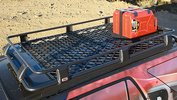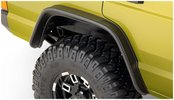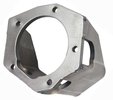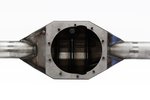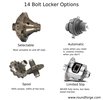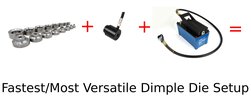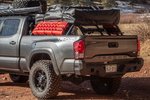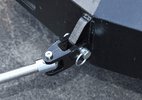What Size Winch Do I Need?
We all know that a winch can mean the difference between spending the night in your 4x4 in the middle of nowhere or having a pleasant, challenging cruise down the trail followed by a warm bed.
But you're wondering:
How do I know what size winch I need?
Winch weight ratings don't transfer over directly to the size vehicle they can extract.
So, in this article, we'll take a look at some common vehicles and what size winch they need. We'll also include a calculator that you can use if your 4x4 isn't on our list.
- Winch Database
- The Best Winch Accessories For Off Roading
- The Best 10000 lb Winches
- Coupon code: 10% off $500 or more at 4 Wheel Parts (SD4WP10OFF)
- Coupon code: 5% off entire purchase at 4 Wheel Parts (4WPAFEXAPR5)
- Smittybilt has just come out with the Gen3 winches (we haven't added the Gen3 winches to our database yet). There are some massive deals for the Gen2 winches (until they run out). Some Gen2 accessories like bumpers are also being discounted.
- Warn's 3rd generation VR EVO winches are replacing the 2nd Generation VR winches. There are some decent deals if you want a 2nd Gen Warn VR.
- 4 Wheel Parts has free shipping on most winches.
The Winch Size Calculator
Step 1: Enter your GVWR.
Step 2: Pick a winch.
| If the winch is red, like this: | A Too-Small Winch | ...it's too small. |
| If the winch is green, like this: | A Just-Right Winch | ...it's the right size. |
| If the winch is yellow, like this: | A Too Big Winch | ...it's too big. |
DEALS for Roundforge readers!!
What Is GVWR?
GVWR is Gross Vehicle Weight Rating. It's also known as GVM, or Gross Vehicle Mass. It refers to the maximum operating weight of your 4x4 including the vehicle passengers and driver, fuel, camping gear, tools, and any modifications you've made.
It isn't something that you figure out:
The
GVWR is designated by the manufacturer. While you'd think it'd be easy to find online, it isn't.
Instead, go out to your rig and find it! All vehicles have the GVWR marked on the body. It's usually on a tag on the driver side door jamb.
Sometimes it's under the hood on a sticker or in your owner's manual.

This robust 8000 lb winch has an IP68 water resistance rating. The lightweight, large diameter, aluminum drum will reduce winch cable wear.
We're not going to go into all the details of choosing a winch. Besides deciphering all the features on a winch, actually finding out what size you need for your truck or Jeep can be kind of difficult.
Why is that?
Winch ratings don't actually tell you the whole story about how much a winch can pull. A weight rating is really the maximum capacity that the winch will pull under optimum conditions.
What's optimum?
A straight pull, with a single cable, with one wrap on the drum, and a perfect electrical system.
Winches with a Full Spool of Cable Are Weak
Winches are rated with one wrap on the drum.
What's that mean?
A winch is most powerful when it has a single wrap of steel cable or synthetic rope on the drum. This means that if your winch anchor is close and you have a lot of winch line on the drum, your winch is actually weaker - sometimes much weaker.
At the first wrap of winch cable, your winch can pull with it's max strength. However with each additional wrap, you lose about 10% of the pulling capacity. (The loss varies depending on a few factors, but 10% gets us in the ball park.)
| Layers of winch line | Pulling power | Power loss |
|---|---|---|
| 1 layer | 8,000 lbs | Full power |
| 2 layers | 7,040 lbs | 12% |
| 3 layers | 6,195 lbs | 23% |
| 4 layers | 5,452 lbs | 32% |
| 5 layers | 4,798 lbs | 40% |
| Layers of winch line | Pulling power | Power loss |
|---|---|---|
| 1 layer | 10,000 lbs | Full power |
| 2 layers | 8,800 lbs | 12% |
| 3 layers | 7,744 lbs | 23% |
| 4 layers | 6,815 lbs | 32% |
| 5 layers | 5,997 lbs | 40% |
What does this mean when you're on the trail?
With a winch drum full of cable, you'll lose 40% your winch's rated pulling power! Solve this by pulling out most of your cable if you can (always leave at least 5 wraps on the drum) when you need to winch. Use winch anchors that are far away.
This is where lightweight synthetic winch rope shines.
Bad Juice Equals Weak Winch
An underrated battery, undersized cables, or bad electrical connections will suck the power out of your electric winch.
Here's the deal:
Winches run off the battery and need a certain amount of amps to operate. Small, weak, or old batteries just won't cut the mustard if you get into a serious recovery situation. Your alternator isn't as important.
However:
Your alternator recharges your battery while your winch drains it. The larger your alternator, the faster your battery will charge from winch use. It's completely possible to use your winch so much that your alternator can't keep up, especially with lower-amp stock alternators.
And there's one more problem people have:
Wiring. Your wiring connections have to be excellent. This means direct connections to the battery positive and negative terminals that are pristine and uncorroded. Bad connections are frequently the cause for a winch losing power inexplicably.
Cable Redirections Sap Power
| Pulling power | Efficiency loss | |
| Single line pull | 10,000 lbs | 0% |
| Double line pull with snatch block | 18,000 lbs | 10% |
Under otherwise optimal conditions.
Fairleads and snatch blocks are 100% necessary for winching.
A fairlead allows you winch from an tree off to the side when your mired to your axles in a mud bog without grinding a groove through your bumper. A snatch block allows you to change the direction of a winch pull or amplify the pulling power of your winch.
The problem:
Fairleads and snatch blocks generate friction and resistance and reduce the pulling power of the winch.
But don't get confused with snatch blocks:
Snatch blocks will nearly double the amount that your winch can pull. We say "nearly" because using it in a double line pull results in a 10% power loss overall. What this really means is that when someone says that "A snatch block can double your line pull," it's not really an accurate statement (We are guilty of this, too.).
About the calculator....
The calculation that we use to find out winch capacity is GVWR x 1.5. This is the industry standard.
However:
This model can break down with really large trucks that have extremely high GVWRs. If you're not carrying a load of stone down the trail in your big truck, you can probably take your curb weight and add 1,500 lbs for mods and gear. Use that weight to figure out your minimum winch size.
But....
With Winches, Bigger Is Always Better
Heavily packed or equipped rigs should get a winch that's the next size up.
Even though 1.5X is the industry standard, you can still pick a different size winch. If you travel extremely light, you could get a smaller winch (we don't recommend it). But you can never go wrong with a bigger winch. When you're completely high-centered on rocks in a canyon in the 100 degree desert, do you think you're going to say, "Gee, I wish my winch was smaller"? Of course not.
A bigger winch is less likely to stall, less likely to overheat, needs less cool down time, and has more power when you need it most.
Plus:
A lot of people seriously overload their 4x4s, even beyond the GVWR. If you're that guy that brings everything on a wheeling trip, you should seriously consider a winch that's the next size up.
With winches, bigger is always better.
GVWRs and Winch Sizes
| Year | Make | Model | GVWR | Minimum Winch Size |
|---|---|---|---|---|
| 1983 | Toyota | Pickup Truck | 4,800 lbs | 8,000 lbs |
| 2009 | Toyota | 4Runner | 5,330 lbs | 8,000 lbs |
| 2009 | Toyota | Tacoma | 5,350 lbs | 8,000 lbs |
| 2017 | Toyota | Tacoma | 5,600 lbs | 9,500 lbs |
| 2007 | Toyota | FJ Cruiser | 5,570 lbs | 9,500 lbs |
| 2008 | Ford | F250 Supercab 4x4 | 10,000 lbs | 15,000 lbs |
| 2017 | Jeep | 4 door Wrangler Rubicon | 5,600 lbs | 9,500 lbs |
| 2017 | Jeep | 4 door Wrangler Rubicon | 5,000 lbs | 8,000 lbs |
Last updated: November 18, 2019
